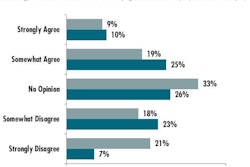While the Institute of Food Technologists (IFT) focuses mainly on the human food industry, many of the organization’s initiatives, including its annual meeting, are applicable to petfood as well. In fact, when I attended IFT’s 2012 Annual Meeting & Food Expo June 25–28 in Las Vegas, Nevada, USA, to speak about petfood regulations, I ran into several people from the petfood industry who have been IFT members for years. (With over 18,000 attendees, it was a big show.)
Briefly, IFT is an association for food science and technical professionals. Its stated mission is to “advance the science of food” with a long-range vision “to ensure a safe and abundant food supply contributing to healthier people everywhere.” In addition to its roles in fostering research and innovation in the field and serving as an advocate on matters relating to the advancement of food science, much of its efforts include education of its members through meetings, publications and online courses. Some areas of focus include:
- Health and nutrition;
- Food safety and defense;
- Product development and ingredient innovations; and
- Public policy, food laws and regulations.
Though the main function of IFT is with respect to foods for human consumption, the organization has taken an interest in the unique issues involving petfood in recent years. Along with my presentation, other talks on petfood at the annual meeting included discussions on the global petfood marketplace and petfood ingredient sourcing.
Frankly, the session in which we spoke was not scheduled at the most ideal time (7:15 AM), nor was the amount of time given to each speaker very long (15 minutes). However, it was well attended, and the audience enthusiastically engaged the speakers with many questions. I think IFT was impressed with the outcome. It is my understanding that the organization intends to offer more presentations on petfood at future meetings.
Besides the petfood session, over the course of three days there were literally hundreds and hundreds of oral and poster presentations on a wide variety of topics. These included but were definitely not limited to:
- Food defense, traceability, toxicology and safety evaluation;
- New ingredients and functional foods;
- Food chemistry, engineering, processing and packaging;
- Analytical methods;
- Food laws and regulations, public policy;
- Biotechnology;
- Sensory evaluation;
- Marketing;
- International issues; and
- Sustainability.
In addition to the scientific sessions, I also very much enjoyed the Food Expo component of the meeting. With over 1,000 exhibits, there appeared to be a booth to address every facet of the food industry. While many exhibits displayed processing, packaging and laboratory equipment and supplies and a host of other services for the industry, most were purveyors of ingredients and additives, ranging from amino acids to yeast extracts with everything you can think of in between.
The best part (for me, anyway) was that many of them provided samples of foods featuring their respective ingredients. If one was so inclined, it would be easy to get one’s fill at the expo without purchasing any food for the day. (I am sure some of the food concessions in the convention center were not happy.) Honestly, I was not impressed with everything I sampled, but did find some tasty (and purportedly healthful) offerings.
More information about IFT is available at www.ift.org. Next year’s annual meeting will be held in mid-July in Chicago. Many people in the petfood industry might find it interesting, but I would especially encourage scientists involved in the research, development, formulation and manufacturing of petfood to attend.

















